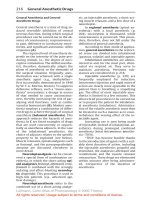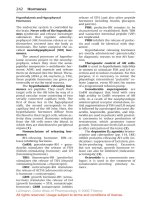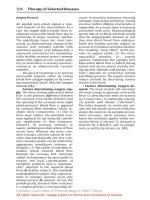Color Atlas of Pharmacology (Part 20): General Anesthetic Drugs
Bạn đang xem bản rút gọn của tài liệu. Xem và tải ngay bản đầy đủ của tài liệu tại đây (349.7 KB, 10 trang )
General Anesthesia and General
Anesthetic Drugs
General anesthesia is a state of drug-in-
duced reversible inhibition of central
nervous function, during which surgical
procedures can be carried out in the ab-
sence of consciousness, responsiveness
to pain, defensive or involuntary move-
ments, and significant autonomic reflex
responses (A).
The required level of anesthesia de-
pends on the intensity of the pain-pro-
ducing stimuli, i.e., the degree of noci-
ceptive stimulation. The skilful anesthe-
tist, therefore, dynamically adapts the
plane of anesthesia to the demands of
the surgical situation. Originally, anes-
thetization was achieved with a single
anesthetic agent (e.g., diethylether—
first successfully demonstrated in 1846
by W. T. G. Morton, Boston). To suppress
defensive reflexes, such a “mono-anes-
thesia” necessitates a dosage in excess
of that needed to cause unconscious-
ness, thereby increasing the risk of par-
alyzing vital functions, such as cardio-
vascular homeostasis (B). Modern anes-
thesia employs a combination of differ-
ent drugs to achieve the goals of surgical
anesthesia (balanced anesthesia). This
approach reduces the hazards of anes-
thesia. In C are listed examples of drugs
that are used concurrently or sequen-
tially as anesthesia adjuncts. In the case
of the inhalational anesthetics, the
choice of adjuncts relates to the specific
property to be exploited (see below).
Muscle relaxants, opioid analgesics such
as fentanyl, and the parasympatholytic
atropine are discussed elsewhere in
more detail.
Neuroleptanalgesia can be consid-
ered a special form of combination an-
esthesia, in which the short-acting opi-
oid analgesics fentanyl, alfentanil, remi-
fentanil is combined with the strongly
sedating and affect-blunting neurolep-
tic droperidol. This procedure is used in
high-risk patients (e.g., advanced age,
liver damage).
Neuroleptanesthesia refers to the
combined use of a short-acting analge-
sic, an injectable anesthetic, a short-act-
ing muscle relaxant, and a low dose of a
neuroleptic.
In regional anesthesia (spinal an-
esthesia) with a local anesthetic (p.
204), nociception is eliminated, while
consciousness is preserved. This proce-
dure, therefore, does not fall under the
definition of general anesthesia.
According to their mode of applica-
tion, general anesthetics in the restrict-
ed sense are divided into inhalational
(gaseous, volatile) and injectable agents.
Inhalational anesthetics are admin-
istered in and, for the most part, elimi-
nated via respired air. They serve to
maintain anesthesia. Pertinent sub-
stances are considered on p. 218.
Injectable anesthetics (p. 220) are
frequently employed for induction.
Intravenous injection and rapid onset of
action are clearly more agreeable to the
patient than is breathing a stupefying
gas. The effect of most injectable anes-
thetics is limited to a few minutes. This
allows brief procedures to be carried out
or to prepare the patient for inhalation-
al anesthesia (intubation). Administra-
tion of the volatile anesthetic must then
be titrated in such a manner as to coun-
terbalance the waning effect of the in-
jectable agent.
Increasing use is now being made
of injectable, instead of inhalational, an-
esthetics during prolonged combined
anesthesia (total intravenous anesthe-
sia—TIVA).
“TIVA” has become feasible thanks
to the introduction of agents with a suit-
ably short duration of action, including
the injectable anesthetics propofol and
etomidate, the analgesics alfentanil und
remifentanil, and the muscle relaxant
mivacurium. These drugs are eliminated
within minutes after being adminster-
ed, irrespective of the duration of
anesthesia.
216 General Anesthetic Drugs
Lüllmann, Color Atlas of Pharmacology © 2000 Thieme
All rights reserved. Usage subject to terms and conditions of license.
General Anesthetic Drugs 217
Pain stimulus
C. Regimen for balanced anesthesia
A. Goals of surgical anesthesia
B. Traditional monoanesthesia vs. modern balanced anesthesia
Muscle relaxation Loss of consciousness Autonomic stabilization
Analgesia
Motor
reflexes
Pain and
suffering
Autonomic
reflexes
Nociception
Paralysis of
vital centers
Mono-anesthesia
e.g., diethylether
Reduced pain
sensitivity
Muscle relaxation
Loss of consciousness
Pancur
onium
N
2
O
Halothane
autonom
ic stabilization
Atr
opine
Pentazocine analgesia
Neostigm
ine r
eversal of
neurom
uscular block
M
idazolam
unconsciousness
Pentazocine analgesia
Diazepam
anxiolysis
Muscle relaxation
Analgesia
Unconsciousness
m
uscle r
elaxation; intubation
Succinycholine
Pre-
medication Induction Maintenance Recovery
For
unconsciousness:
e.g., halothane
or propofol
For
muscle
relaxation
e.g., pan-
curonium
For
autonomic
stabilization
e.g.,
atropine
For
analgesia
e.g., N
2
O
or fentanyl
Lüllmann, Color Atlas of Pharmacology © 2000 Thieme
All rights reserved. Usage subject to terms and conditions of license.
Inhalational Anesthetics
The mechanism of action of inhala-
tional anesthetics is unknown. The di-
versity of chemical structures (inert gas
xenon; hydrocarbons; halogenated hy-
drocarbons) possessing anesthetic ac-
tivity appears to rule out involvement of
specific receptors. According to one hy-
pothesis, uptake into the hydrophobic
interior of the plasmalemma of neurons
results in inhibition of electrical excit-
ability and impulse propagation in the
brain. This concept would explain the
correlation between anesthetic potency
and lipophilicity of anesthetic drugs (A).
However, an interaction with lipophilic
domains of membrane proteins is also
conceivable. Anesthetic potency can be
expressed in terms of the minimal al-
veolar concentration (MAC) at which
50% of patients remain immobile fol-
lowing a defined painful stimulus (skin
incision). Whereas the poorly lipophilic
N
2
O must be inhaled in high concentra-
tions (>70% of inspired air has to be re-
placed), much smaller concentrations
(<5%) are required in the case of the
more lipophilic halothane.
The rates of onset and cessation of
action vary widely between different in-
halational anesthetics and also depend
on the degree of lipophilicity. In the case
of N
2
O, there is rapid elimination from
the body when the patient is ventilated
with normal air. Due to the high partial
pressure in blood, the driving force for
transfer of the drug into expired air is
large and, since tissue uptake is minor,
the body can be quickly cleared of N
2
O.
In contrast, with halothane, partial pres-
sure in blood is low and tissue uptake is
high, resulting in a much slower elimi-
nation.
Given alone, N
2
O (nitrous oxide,
“laughing gas”) is incapable of produc-
ing anesthesia of sufficient depth for
surgery. It has good analgesic efficacy
that can be exploited when it is used in
conjunction with other anesthetics. As a
gas, N
2
O can be administered directly.
Although it irreversibly oxidizes vita-
min B
12
, N
2
O is not metabolized appre-
ciably and is cleared entirely by exhala-
tion (B).
Halothane (boiling point [BP]
50 °C), enflurane (BP 56 °C), isoflurane
(BP 48 °C), and the obsolete methoxyflu-
rane (BP 104 °C) have to be vaporized by
special devices. Part of the administered
halothane is converted into hepatotoxic
metabolites (B). Liver damage may re-
sult from halothane anesthesia. With a
single exposure, the risk involved is un-
predictable; however, there is a correla-
tion with the frequency of exposure and
the shortness of the interval between
successive exposures.
Up to 70% of inhaled methoxyflu-
rane is converted to metabolites that
may cause nephrotoxicity, a problem
that has led to the withdrawal of the
drug.
Degradation products of enflurane
or isoflurane (fraction biotransformed
<2%) are of no concern.
Halothane exerts a pronounced hy-
potensive effect, to which a negative in-
otropic effect contributes. Enflurane
and isoflurane cause less circulatory de-
pression. Halothane sensitizes the myo-
cardium to catecholamines (caution: se-
rious tachyarrhythmias or ventricular
fibrillation may accompany use of cate-
cholamines as antihypotensives or toco-
lytics). This effect is much less pro-
nounced with enflurane and isoflurane.
Unlike halothane, enflurane and isoflu-
rane have a muscle-relaxant effect that
is additive with that of nondepolarizing
neuromuscular blockers.
Desflurane is a close structural rela-
tive of isoflurane, but has low lipophilic-
ity that permits rapid induction and re-
covery as well as good control of anes-
thetic depth.
218 General Anesthetic Drugs
Lüllmann, Color Atlas of Pharmacology © 2000 Thieme
All rights reserved. Usage subject to terms and conditions of license.
General Anesthetic Drugs 219
Low potency
high partial pressure needed
relatively little binding to tissue
B. Elimination routes of different volatile anesthetics
A. Lipophilicity, potency and elimination of N
2
O and halothane
Anesthetic potency
Lipophilicity
Nitrous oxide
N
2
O
Xenon
Cyclopropane
Diethylether
Enflurane
Chloroform
Halothane
Partial pressure in tissue
Time
Termination of intake
Partial pressure of anesthetic
Binding
Tissue
Blood Alveolar air
High potency
low partial pressure sufficient
relatively high binding in tissue
Halothane
N
2
O
MetabolitesMetabolites
Halothane
Methoxy-
fluraneEther
Nitrous oxide
N
2
O
H
5
C
2
OC
2
H
5
Lüllmann, Color Atlas of Pharmacology © 2000 Thieme
All rights reserved. Usage subject to terms and conditions of license.
Injectable Anesthetics
Substances from different chemical
classes suspend consciousness when
given intravenously and can be used as
injectable anesthetics (B). Unlike inha-
lational agents, most of these drugs af-
fect consciousness only and are devoid
of analgesic activity (exception: keta-
mine). The effect cannot be ascribed to
nonselective binding to neuronal cell
membranes, although this may hold for
propofol.
Most injectable anesthetics are
characterized by a short duration of ac-
tion. The rapid cessation of action is
largely due to redistribution: after
intravenous injection, brain concentra-
tion climbs rapidly to anesthetic levels
because of the high cerebral blood flow;
the drug then distributes evenly in the
body, i.e., concentration rises in the pe-
riphery, but falls in the brain—redistri-
bution and cessation of anesthesia (A).
Thus, the effect subsides before the drug
has left the body. A second injection of
the same dose, given immediately after
recovery from the preceding dose, can
therefore produce a more intense and
longer effect. Usually, a single injection
is administered. However, etomidate
and propofol may be given by infusion
over a longer time period to maintain
unconsciousness.
Thiopental and methohexital belong
to the barbiturates which, depending on
dose, produce sedation, sleepiness, or
anesthesia. Barbiturates lower the pain
threshold and thereby facilitate defen-
sive reflex movements; they also de-
press the respiratory center. Barbitu-
rates are frequently used for induction
of anesthesia.
Ketamine has analgesic activity that
persists beyond the period of uncon-
sciousness up to 1 h after injection. On
regaining consciousness, the patient
may experience a disconnection
between outside reality and inner men-
tal state (dissociative anesthesia). Fre-
quently there is memory loss for the du-
ration of the recovery period; however,
adults in particular complain about dis-
tressing dream-like experiences. These
can be counteracted by administration
of a benzodiazepine (e.g., midazolam).
The CNS effects of ketamine arise, in
part, from an interference with excita-
tory glutamatergic transmission via li-
gand-gated cation channels of the
NMDA subtype, at which ketamine acts
as a channel blocker. The non-natural
excitatory amino acid N-methyl-D-
aspartate is a selective agonist at this re-
ceptor. Release of catecholamines with
a resultant increase in heart rate and
blood pressure is another unrelated ac-
tion of ketamine.
Propofol has a remarkably simple
structure. Its effect has a rapid onset and
decays quickly, being experienced by
the patient as fairly pleasant. The inten-
sity of the effect can be well controlled
during prolonged administration.
Etomidate hardly affects the auto-
nomic nervous system. Since it inhibits
cortisol synthesis, it can be used in the
treatment of adrenocortical overactivity
(Cushing’s disease).
Midazolam is a rapidly metabolized
benzodiazepine (p. 228) that is used for
induction of anesthesia. The longer-act-
ing lorazepam is preferred as adjunct
anesthetic in prolonged cardiac surgery
with cardiopulmonary bypass; its am-
nesiogenic effect is pronounced.
220 General Anesthetic Drugs
Lüllmann, Color Atlas of Pharmacology © 2000 Thieme
All rights reserved. Usage subject to terms and conditions of license.









